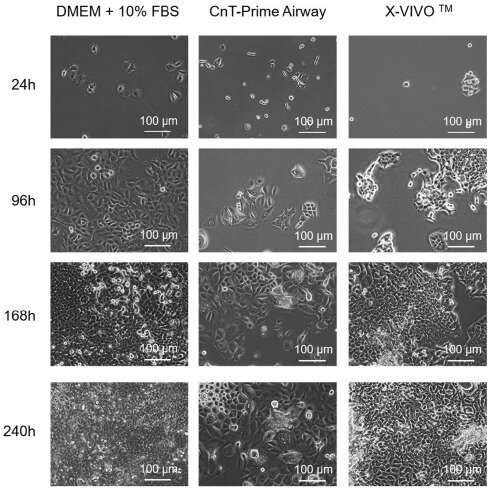Toxicology in Vitro (2022). DOI: 10.116/j.tiv.2022.105423″ width=”489″ height=”530″/>
Microscopic observations of A549 cells grown at 24 hours, 96 hours, 186 hours and 240 hours in DMEM +10% FBS (control), CnT-Prime Airway and X-VIVO media. [Olympus CKX53 light microscope, objective 20×, magnification 200×, temperature 20°C, cell culture imaging medium, XCAM 5.0 MP camera]. Credit: Aline Chary et al, Toxicology in vitro (2022). DOI: 10.116/j.tiv.2022.105423
A new paper by PETA Science Consortium International eV and the Luxembourg Institute of Science and Technology shows how to improve the relevance and reproducibility of research by replacing media containing serum extracted from the blood of unborn calves with animal-free media.
Worldwide, an estimated 1.8 million unborn calves are killed to produce fetal bovine serum (FBS) – an undefined mixture of molecules including hormones, proteins and growth factors obtained from the blood of fetal calves after their mothers are slaughtered for food. FBS, which is used in labs to grow cells in vitro, is a source of variability and contributes to the reproducibility problem in research. Scientific organizations such as the Organization for Economic Co-operation and Development and the European Union Reference Laboratory for Alternatives to Animal Testing have encouraged the transition from the use of FBS to the use of animal-free, chemically defined media.
The newspaper, published in Toxicology in vitro, describes the transition from A549 cells, a human lung cell line often used in research, to cell culture media without FBS or other animal components. The success of this project sets a precedent for making the same transition for other cell types and has far-reaching implications for the field of in vitro research.
“Our study demonstrates the feasibility of using animal-free media, and it provides a template that can be replicated to transfer other cell types to serum-free media,” said Dr. Amy Clippinger, chair of the Science Consortium. “The use of animal-free media has numerous benefits and we encourage researchers to invest in this opportunity to increase the quality and reproducibility of studies.”
Stem cell research paves the way for the production of cultured meat
Aline Chary et al, Maximizing the relevance and reproducibility of A549 cell culture using FBS-free media, Toxicology in vitro (2022). DOI: 10.116/j.tiv.2022.105423
Provided by People for the Ethical Treatment of Animals (PETA)
Quote: Scientists successfully transitioned the cell line to be completely animal-free (2022, July 26) retrieved July 26, 2022 from https://phys.org/news/2022-07-scientists-successfully-transition-cell-line.html
This document is copyrighted. Other than fair dealing for personal study or research, nothing may be reproduced without written permission. The content is provided for informational purposes only.

